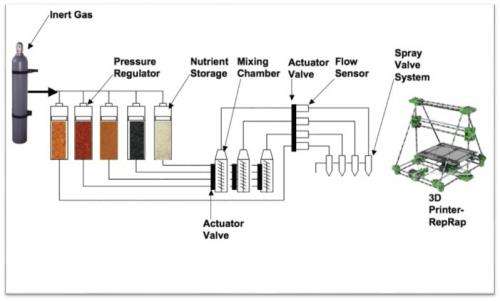May 22, 2013 weblog
NASA: Austin, calling Austin. 3-D pizzas to go

(Phys.org) —The idea of living with 3-D printed food is neither unthinkable nor new; designers and futurists have been looking to 3-D printing as food's next frontier. In 2012, there was news that the Thiel Foundation made a $350,000 donation to Modern Meadow. Co-founded by Gabor and Andras Forgacs, two tech-entrepreneurs, the company focus was on commercialized bioprinting and they were exploring bioprinted meat —applying the basic idea of layering cells using print technology. Now, NASA similarly made a next-frontier move in bestowing a $125,000 grant on Systems & Materials Research Corporation (SMRC) in Austin, Texas. The company has been given the nod from NASA to create a prototype of a food synthesizer. The prototype will follow the company's-proof of concept a chocolate printer, applying a layer of chocolate on to a cracker. The company will move on up to a more nutritional solution. The grant from NASA is for a system that can print food for astronauts on space missions.
The prototype to be worked on will focus on 3-D printed pizza. The choice of pizza is practical in that pizza nutritionally may be a fast food but is not a junk food; its key ingredients have nutrients. Printing-wise, pizza is practical as it consists of layers.
The idea is to print a layer of dough, prepared with a heated plate at the bottom of the printer and then to apply the powdered tomato base mixed with water and oil, topped with a "protein layer."
The SMRC's technical abstract for NASA said the company intends to design, build, and test a complete nutritional system for long duration missions beyond low earth orbit. "The 3D printing component will deliver macronutrients (starch, protein, and fat), structure, and texture while the ink jet will deliver micronutrients, flavor, and smell."
SMRC's abstract said they will team with the food science program at North Carolina State University and International Flavors and Fragrances to ensure the production of nutritious and flavorful mission supplies.
The abstract said that the approach addresses uniform long term storage and nutrition. Macronutrient feed stocks will be stored in dry sterile containers and fed to the printer. Using macronutrients such as protein, starch and fat, the sustenance portion of the diet will come out in a variety of shapes and textures directly from the 3-D printer, already warm. At the print head, stocks will be combined with water or oil through a digital recipe. Flavors and texture modifiers will be added.
.
Beyond 3-D printed food for astronauts, though, the company mantra,"We embrace science to engineer a smarter, more sustainable world" is not lost on team member, Anjan Contractor, who is a senior mechanical engineer. He said that he can see a time when 3-D printers will be put to daily use. People will prepare meals one layer at a time using cartridges of powder and oils. He said a 3D printer could provide personalized nutrition as well.
Funding for the food-synthesizer prototype is from the NASA Small Business Innovation Research (SBIR) program.
© 2013 Phys.org





















